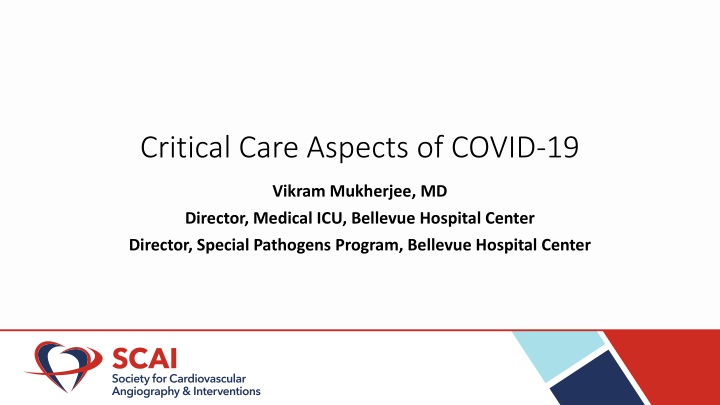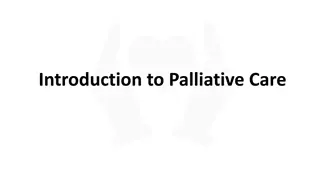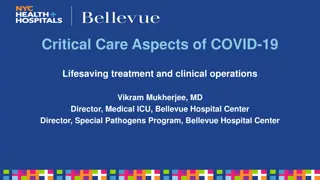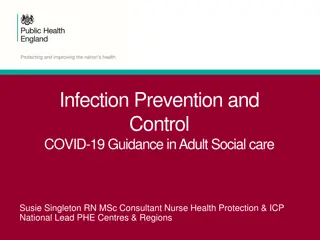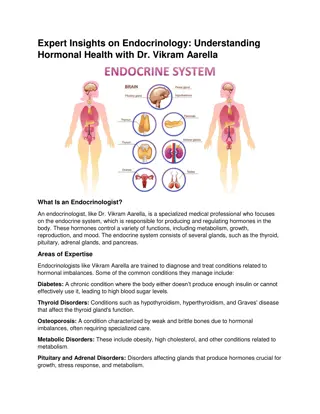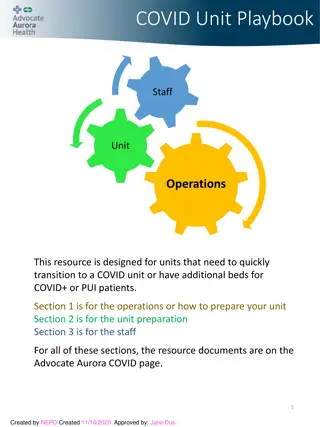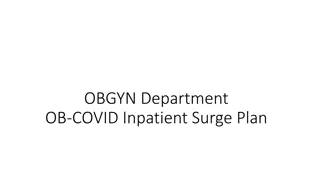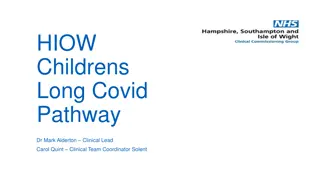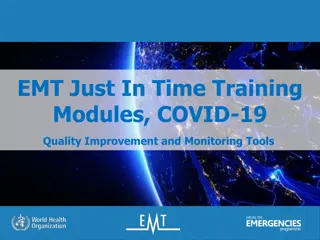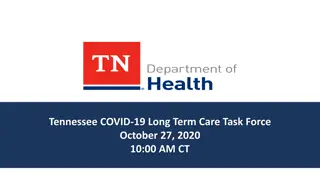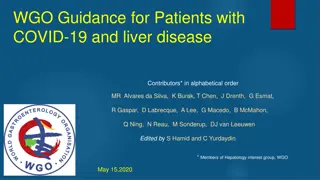Critical Care Aspects of COVID-19: Insights from Dr. Vikram Mukherjee, MD
Explore the critical care aspects of COVID-19 discussed by Dr. Vikram Mukherjee, MD, covering clinical characteristics, organ dysfunction, outcomes, inflammatory surge, X-ray findings, and more. Gain insights on the presentation, progression, and management of severe cases, including ARDS, cytokine storm, renal failure, and hypercoagulable state.
Download Presentation

Please find below an Image/Link to download the presentation.
The content on the website is provided AS IS for your information and personal use only. It may not be sold, licensed, or shared on other websites without obtaining consent from the author.If you encounter any issues during the download, it is possible that the publisher has removed the file from their server.
You are allowed to download the files provided on this website for personal or commercial use, subject to the condition that they are used lawfully. All files are the property of their respective owners.
The content on the website is provided AS IS for your information and personal use only. It may not be sold, licensed, or shared on other websites without obtaining consent from the author.
E N D
Presentation Transcript
Critical Care Aspects of COVID-19 Vikram Mukherjee, MD Director, Medical ICU, Bellevue Hospital Center Director, Special Pathogens Program, Bellevue Hospital Center
Clinical aspects: overall impressions so far Presentation Clinical Characteristics Organ dysfunction Outcomes
Onset of symptoms Presentation to ER Admitted to floor Worsening hypoxia Admitted to ICU Severe ARDS Cytokine Storm Renal failure Ongoing ventilator and RRT needs Death
Onset of symptoms Presentation to ER Admitted to floor Worsening hypoxia Onset of symptoms Presentation to ER Admitted to ICU Severe ARDS Cytokine Storm Ongoing Renal failure ventilator and RRT needs Death
Age (y) 60 40.1% 38.7% 50 40 21.2% 30 20 10 0 18-49 50-64 >65
Age (y) M=72% M=72% 60 40.1% 38.7% 50 40 21.2% 30 20 10 0 18-49 50-64 >65
XRAY FINDINGS 100% 90% 79.60% 80% 70% 60% 50% 40% 30% 20% 9.50% 10% 6.60% 3.60% 0% Clear Lobar Consolidation Multifocal infiltrates Interstitial abnormalities
Inflammatory Surge: Elevation in markers 120% 100% 80% 60% 40% 20% 0% D-dimer Ferritin Troponin LDH CRP IL-6
Clinical Characteristics 100% 90% 80% 70% 60% 50% 40% 30% 20% 10% 0% ARDS Shock State Renal Replacement Tracheostomy Death
Organ Dysfunction ARDS Cytokine Storm Renal failure Hypercoagulable state
Severe ARDS Conventional management: Trial of HFNC Lung Protective Strategy ARDSNET peep/fio2 ladder, though some patients improve on lower PEEPs Account for insensible losses and undetected hypovolemia Recruitment Attention to fluid balance Trial of antibiotics Neuromuscular blockade and RASS-4 sedation iNO for refractory hypoxia Manual proning ECMO
Severe ARDS Other issues CVL and A-line in most patients Prefer left IJ CVL Many have substantial sedation requirements Many need neuromuscular blockade to achieve ventilator dysynchrony Tracheostomy team with protocolized bedside PDT Plaquenil/Azithromycin Watch Qtc Family updates
Cytokine Release Syndrome Common to see the following a few days into ICU course Recurring marked fevers in the absence of obvious infectious source Tachycardia, tachypnea, diaphoresis Elevated CRP, ferritin, LDH, IL-6 Trend daily (except IL-6) D-Dimer Progression to renal failure ~30% of our ICU patients are in acute renal failure requiring RRT Unclear on how to mitigate Steroids Risks Anti- IL6 No clear data on efficacy
Renal Replacement Therapy (RRT) High incidence of AKI requiring RRT Unclear etiology Role of Peritoneal Dialysis in crisis situations
Hypercoagulability High incidence of arterial and venous thromboembolism Inflammatory milieu Virus- induced endothelial damage D-dimer as a surrogate of clot formation Further studies ongoing to define risk & therapies
Other considerations No evidence based treatment Critical care support is the mainstay of therapy Altered standard of care Role of POCUS Things move slowly Has repercussions on management choices Levels of sedation Timing of invasive interventions
Need for a multidisciplinary approach Tracheostomy team Proning team Palliative care team Procedure team Renal Replacement Therapy Team Site manager team
